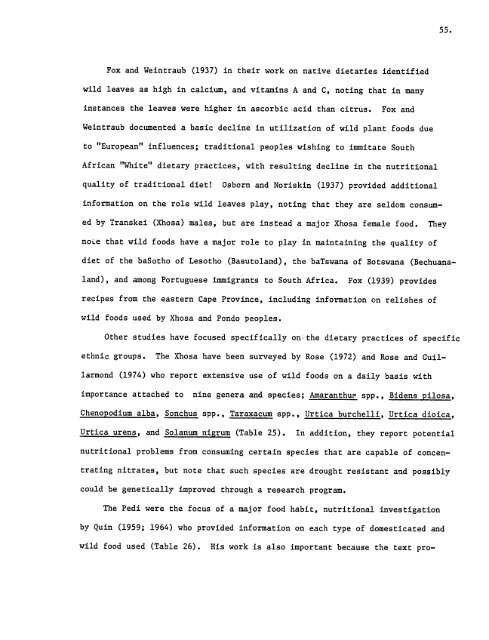BIBLIOGRAPHIC DATA SHEET
BIBLIOGRAPHIC DATA SHEET
BIBLIOGRAPHIC DATA SHEET
You also want an ePaper? Increase the reach of your titles
YUMPU automatically turns print PDFs into web optimized ePapers that Google loves.
Fox and Weintraub (1937) in their work on native dietaries identified<br />
wild leaves as high in calcium, and vitamins A and C, noting that in many<br />
instances the leaves were higher in ascorbic acid than citrus. Fox and<br />
Weintraub documented a basic decline in utilization of wild plant foods due<br />
to "European" influences; traditional peoples wishing to immitate South<br />
African "White" dietary practices, with resulting decline in the nutritional<br />
quality of traditional diet! Osborn and Noriskin (1937) provided additional<br />
information on the role wild leaves play, noting that they are seldom consum<br />
ed by Transkei (Xhosa) males, but are instead a major Xhosa female food. They<br />
noLe that wild foods have a major role to play in maintaining the quality of<br />
diet of the baSotho of Lesotho (Basutoland), the baTswana of Botswana (Bechuana<br />
land), and among Portuguese immigrants to South Africa. Fox (1939) provides<br />
recipes from the eastern Cape Province, including information on relishes of<br />
wild foods used by Xhosa and Pondo peoples.<br />
Other studies have focused specifically on the dietary practices of specific<br />
ethnic groups. The Xhosa have been surveyed by Rose (1972) and Rose and Guil<br />
larmond (1974) who report extensive use of wild foods on a daily basis with<br />
importance attached to nine genera and species; Amaranthus spp., Bidens pilosa,<br />
Chenopodium alba, Sonchus spp., Taraxacum spp., Urtica burchelli, Urtica dioica,<br />
Urtica urens, and Solanum nigrum (Table 25). In addition, they report potential<br />
nutritional problems from consuming certain species that are capable of concen<br />
trating nitrates, but note that such species are drought resistant and possibly<br />
could be genetically improved through a research program.<br />
The Pedi were the focus of a major food habit, nutritional investigation<br />
by Quin (1959; 1964) who provided information on each type of domesticated and<br />
wild food used (Table 26). His work is also important because the text pro<br />
55.

















